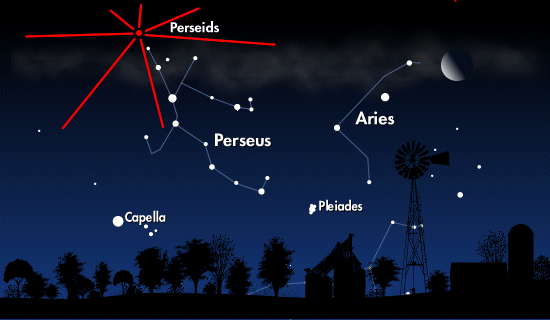Here come the Perseids!
04 August 2014
Sky watchers will be in for a treat in mid-August, when the annual Perseid meteor shower reaches its peak! If you have never before seen a meteor, this is the ideal opportunity. The shower lasts from late July until 20 August, with maximum activity expected between 11 and 13 August. The sky will be dark, as the crescent Moon will be setting below the horizon in mid-evening. And the night should also be warm, so you won’t even need to wrap up! Just keep away from bright lights, let your eyes adapt to the darkness, then lie back and stare at the sky.
Perseids are named after the constellation of Perseus, from which they seem to radiate outwards. However, they can appear anywhere in the sky. The best direction to look is wherever your sky is darkest, probably straight up. The constellation is low in the north-northeast before midnight and rises higher above the horizon during the early morning. The shower is best observed from 11 pm or midnight onwards, when you may see 60-100 meteors per hour.
The Perseids are sand- to pea-sized bits of rocky debris that were ejected long ago by comet Swift-Tuttle. The comet is slowly disintegrating as it orbits the Sun. Over the centuries, its crumbly remains have spread along its orbit to form a stream of particles hundreds of millions of kilometres long.
Earth’s path around the Sun carries us through this comet debris every mid-August. The particles, or meteoroids, are travelling at 60 km per second with respect to Earth. When one of them hits the upper atmosphere, it creates a white-hot streak of superheated air. Occasional brighter ones may survive for several seconds, leaving short-lived trails of glowing smoke and gas.
The Perseids are ideal for digital imaging. Attach your camera to a tripod, preferably with a wide angle lens and a high ISO (darkness) setting. Keep the shutter open for 10-15 seconds at a time (longer in a really dark place). With a bit of luck, you should capture one or more Perseids streaking across the photo!






